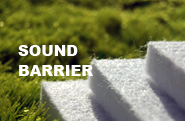
PRODUCT RANGE
WORKPLACE ACOUSTICS
Need of Workplace Acoustics

Open offices over traditional office settings are immediately faced with new challenges, one of them being the task of designing an environment that enables employee productivity, health, and safety. A large facet of this challenge involves accounting for the way the office sounds. How do you ensure your employees are not distracted several times throughout the day because of office noise? How do you protect your employees from unnecessary stress?
"Every component of an office must work in concert in order to experience an ideal acoustic setting. The important components refers to include:
- Systems furniture
- Partition height and composition and material
- Space planning
- Ceiling height and material
- Wall treatment with Acoustic Materials
- HVAC noise and design
- Sound Masking System—Direct Field
Electronic system that is direct-field, installed in the workspace. Miniature emitters uniformly disperse a pre-programmed, spectra-appropriate sound through 4 sequenced channels.
Benefits of Good Workplace Acoustics
When open offices are designed correctly, the space becomes a powerful business tool, enabling the company to save money while facilitating communication and encouraging teamwork. Companies adopting open offices run the risk of hindering business success for the sake of saving money. Failing to consider the design, installation, and maintenance of each specified component could result in an office where employees simply pluck away at keyboards, answer phones, and crunch numbers, essentially defeating the purpose of an innovative open-office system.
Noise control plays an important role in office comfort, productivity and privacy/confidentiality. Studies show that a positive environment has a positive effect on business. Attention needs to be given to noise control, room acoustics, and services.
Open plan offices require a degree of privacy which is achieved to some extent by masking sounds.
Senior managers expect more noise control and require it for confidentiality.
Seminar and meeting rooms, and walls between tenants need to protect the amenity value of users.
Noise Control Systems have been specially designed and developed with extensively independently testing and evaluation to suit the requirements. State of the Art Technology in Noise Control Systems has high performance Sound Proofing and Cost Effective Design for Sound transmission control walls and ceilings.
The Time is Now
There is an urgent, practical need to reduce distractions and to create productive work environments in open plan and architecturally dramatic workspaces. There is an increasingly urgent need to ensure confidential speech privacy in a variety of settings from private offices in the workplace, to financial service and healthcare environments. Acoustical considerations are at the forefront.
The ABC's of Workplace AcousticsThere are three ways to improve workplace acoustics and solve your sound problems – the ABC’s. ABC's of office acoustics to help explain the essentials of achieving comfortable, highly productive work environment.
A = Absorb (via Acoustic Wall & Ceiling tile)
B = Block (via workstation panels) and
C = Cover-up (via electronic sound masking)
While all three of these are recommended to achieve optimal results, C = Cover-up by increasing background sound produces the most dramatic improvement in speech privacy –– with the least disruption and the lowest cost.
In your role as facility manager, you are the expert; you anticipate problems with your work environment and respond to complaints. In this valued role, you need to know about SOUND MASKING and you need to know about GOLDEN HARVEST Sound Management!
Workspace Trends Reduce Acoustical Comfort
“It’s too noisy.” “It’s too quiet.” “Co-workers can hear my private conversations.” These are common complaints and indications of a sound problem due to poor workplace acoustics.
Lower cubicle heights, increased density in smaller and smaller workspaces, and trends such as open ceilings, lightweight modular walls and exposed beams have worsened workplace acoustics. While positive contributions have been made by sound-absorbent and sound-isolating building materials, highly sound absorbent ceiling tiles, quieter office machines, and quieter HVAC systems – by and large, current trends in the workspace have had a detrimental effect on speech privacy and acoustical comfort.
Pressure to increase productivity at the lowest cost possible is constant. Pressure to ensure speech privacy in a variety of settings—from private and executive offices, to financial services and healthcare environments—is at the forefront. Improving workplace acoustics is the solution.
Improving Workplace Acoustics, The ABC’s
There are three ways to improve workplace acoustics and solve your sound problem—the ABC’s. A=Absorb (usually via ceiling tile); B=Block (via workstation panels, wall placement and workspace layout); and C=Cover-up (via electronic sound masking). While all three factors are needed to achieve optimal results, C=Cover-up by increasing background sound produces the most dramatic improvements in speech privacy, with the least disruption and the lowest cost.
Sound Masking: The Best Solution to Your Sound Problem
Sound masking is the addition of a familiar sounding air conditioning-like background sound to an environment, intended to “cover-up” unwanted conversations. It may seem counter-intuitive to add sound to eliminate sound, but it works. Here’s an analogy. Imagine you are in a darkened room and a child is flicking a flashlight on and off. The light is noticeable. Now imagine that the lights are on. The same flashlight is now unnoticed; it has been masked. This is how sound masking works.
Any sound can mask speech, if it is loud enough. Rain, water flow, background music, HVAC systems, and locally controllable sources like radios, “white noise” devices you can buy for $50, or background music all can be used to mask unwanted sound. However, as in the light analogy above, you can mask the child's flashlight with a floodlight or you can raise the light in the room only to a level where it simply dims the impact of the flashlight.
This is how a dedicated sound masking systems works. The sound produced with a Qt Quiet technology™-based sound masking system mirrors the spectrum of the human voice.
AITarget Workspace
Application
.00 – .05
Confidential speech privacy
Healthcare setting
.05 – .20
Normal privacy
Open office plan
.20 – .35
Marginal privacy
Team work areas
.50 – .65
Good communication
Cafeterias
.65 – 1.00
Excellent communication
Operating room or airplane cockpit
How does an Acoustical Consultant work with GOLDEN HARVEST Architectural Acoustics?
Golden Harvest Architectural Acoustics’ vision is to increase awareness and sensitivity to good workplace acoustics. That's your objective too. You know the acoustical improvements implicit in a sound masking system are the easiest, fastest, most demonstrable and the least expensive alternative to improving speech privacy. Just turn the system off after it has been on – everyone will notice. A more subtle change, for example, is opting for cubicle partitions with a higher NRC (Noise Reduction Class), while sometimes important, will contribute much less to privacy.
Specification, design and layout, as well as post-installation checkout are components of each Qt Quiet technology™-based system installation. In small, straightforward spaces, Golden Harvest Architectural Acoustics or one of our qualified resellers or installers typically provides these services. However, in large and/or unique spaces, an acoustical consultant is often retained to provide these services.
Larger and complex spaces typically require the consideration of broader workplace acoustical considerations than the masking system alone. The selection of building materials, cubicle partition height and material, workspace placements, walled office placement, air duct booting, HVAC/mechanical system noise control and general workplace planning are all part of good office design: sound masking is just a piece.
Environment & Space
Workplace Acoustics
Office Acoustics
Auditorium Acoustics
Cinema & Theater Acoustics
Home Acoustics
Healthcare Acoustics
Educational Acoustics
Studio Acoustics





GOLDLINE® is a registered trademark of Golden Harvest LLC | Golden Harvest reserves the right to change x`x`specifications without prior notice.
The data in this document is for information only and may not be considered as binding. Colours in the prints may be slightly different from the actual ones.
Golden Harvest LLC



